Cooking Srilankan Lamprais at home… what a delicious and elaborate tribute to the country where we set up our first home – Srilanka!
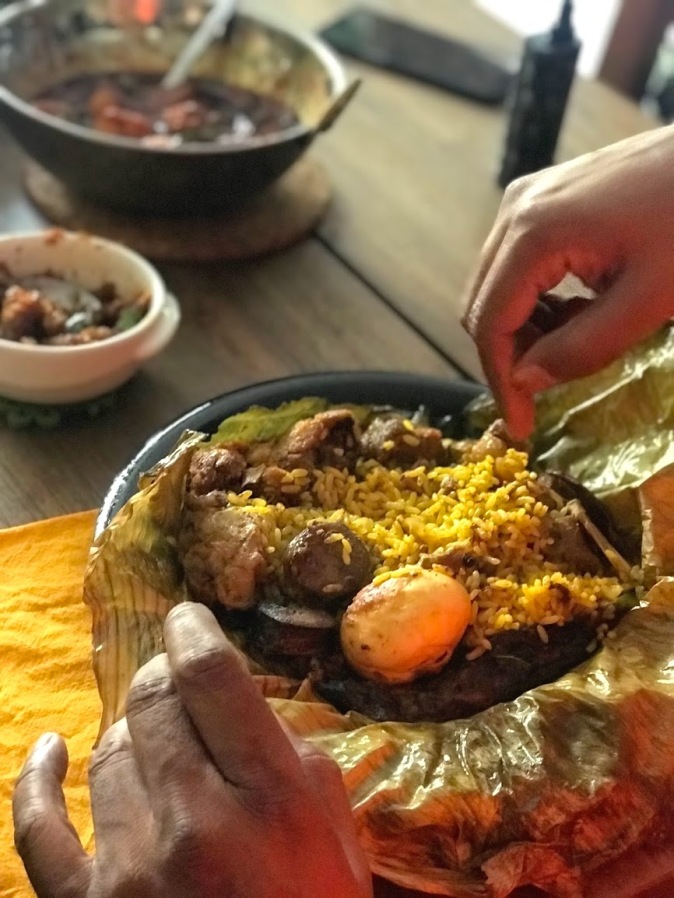
On the day of Guru Purnima when one pays homage to their gurus or teachers, I wanted to pay homage to a country that has taught me a lot – Srilanka! I cooked Lamprais and Deviled Prawns at home, both very popular Srilankan dishes… delicious and elaborate tributes to the country where we set up our first home. Lamprais is a rice preparation where Kaha Bath or yellow rice, along with Lampara meat curry, fried plantain cooked in coconut curry, Wambatu Moju or an eggplant preparation, seeni sambol, fish cutlet and others… all are delicately wrapped up in a banana leaf and cooked in an oven. A Dutch-Burgher influenced dish, Lamprais is a reminiscent of the Dutch colonisation of the island country. Cooking the Lamprais was much more time consuming than I had originally expected with so many things accompanying it. Digging into the lumped rice by hand was mandatory, at least in our home!
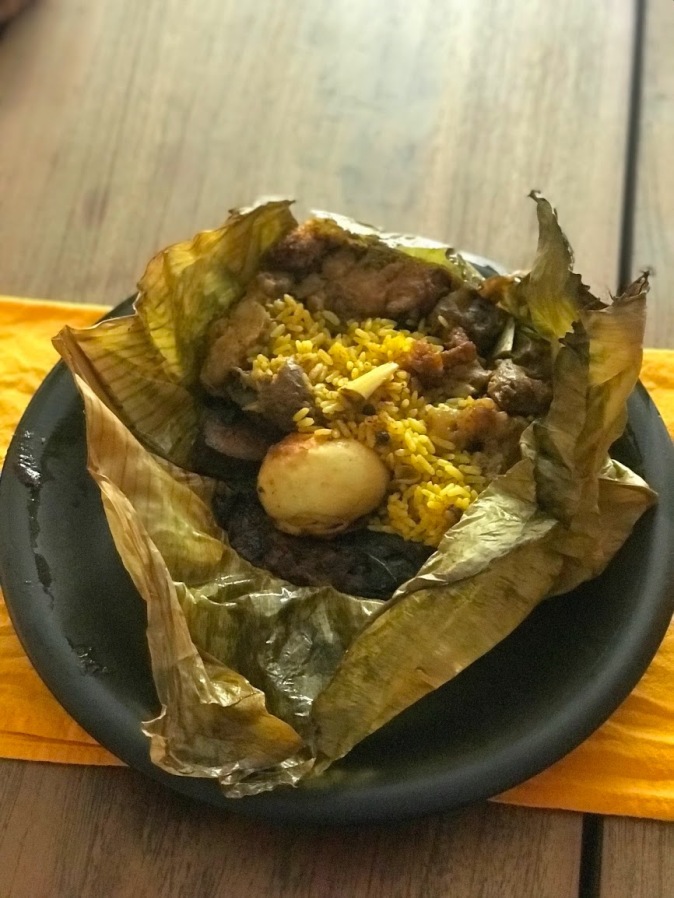 Cooking Lamprais is quite elaborate as there are several accompaniments with lumped rice
Cooking Lamprais is quite elaborate as there are several accompaniments with lumped rice
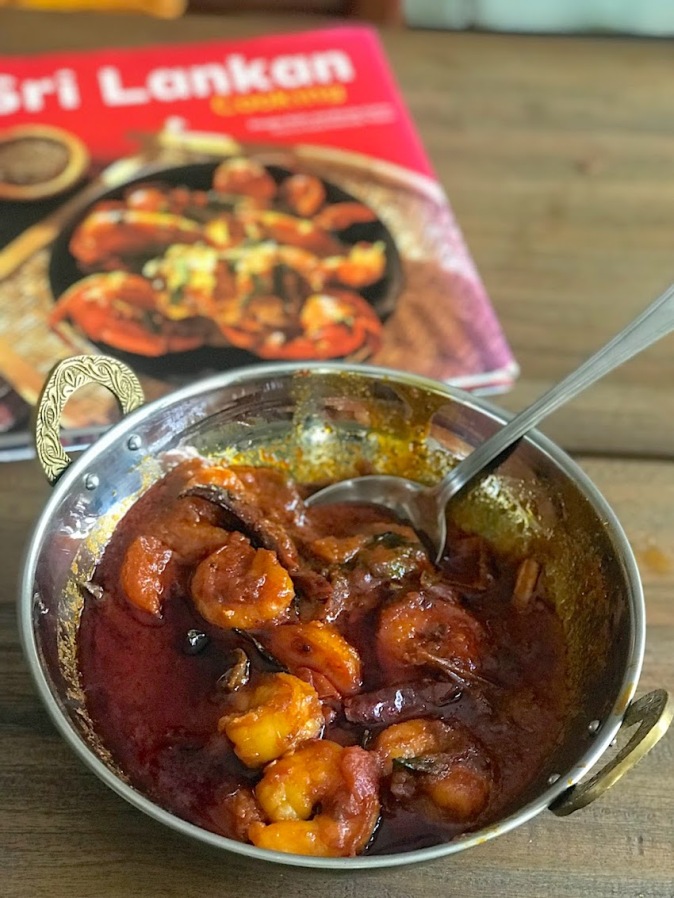 Spicy deviled prawns – Srilankans love their spices and I don’t think a Srilankan dish can ever be spicy enough!
Spicy deviled prawns – Srilankans love their spices and I don’t think a Srilankan dish can ever be spicy enough!
My Srilankan Sojourn – the pre digicam and smartphone era… does anyone even remember the era?
I landed in Colombo in January 1998, a few days after our wedding. This was my first trip to a foreign land and Colombo didn’t disappoint my idea of how ‘abroad’ looked – imported cars, beautifully marked roads, supermarket isles with neatly stacked glossy products, branded clothes and everything that I had imagined. What I hadn’t imagined was the intensity of the tropical lush greenery and verdant landscape, or the eternally smiling friendly faces – quite a contradiction to the regular army checkpoints at roadsides, where we were stopped frequently to show our identity cards. Carrying our passports with us became as natural as carrying our wallets and handbags – even to the neighbourhood grocery. The country was in civil war and waking up to news of bomb explosions far and wide was as normal to us as waking up to the birds’ chirping in our garden. S had been living in Srilanka for a while and was quite used to the on going situation. I found it rather disturbing initially. It was also difficult to explain to our parents back home during our weekly calls that we were – safe and doing fine. After the initial panic buttons were switched on for a while after such unprecedented events, I realised that life bounced back to our familiar understanding of normalcy pretty soon.
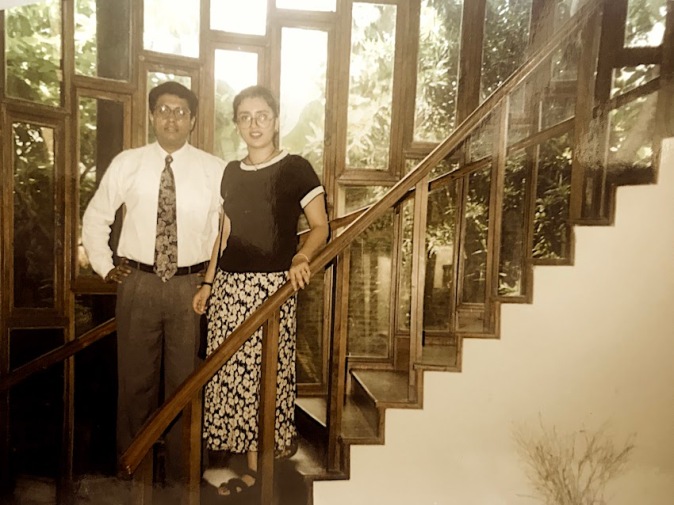
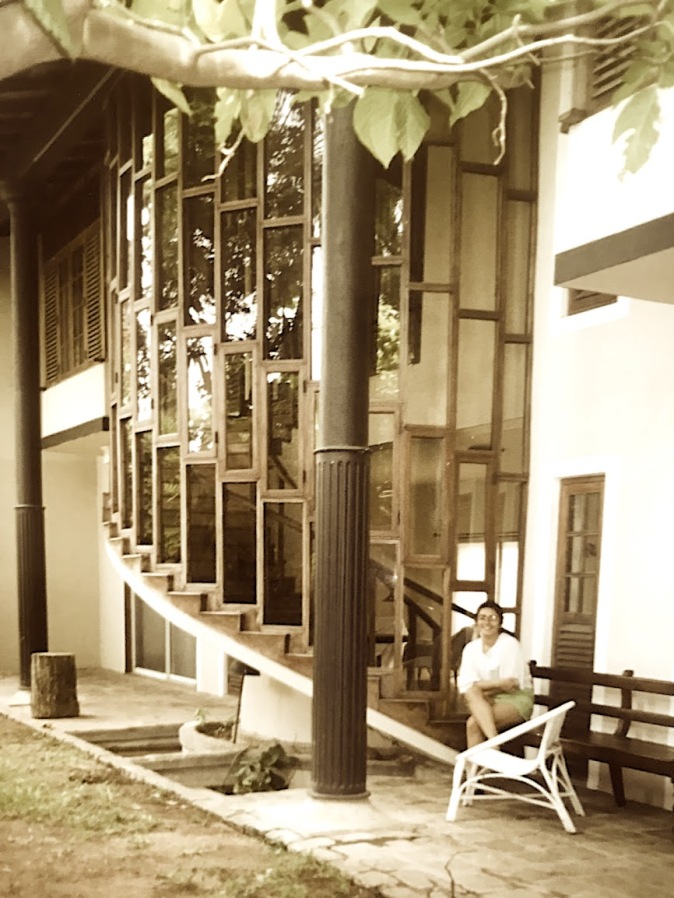 The beautiful staircase in our home at Rosmead Place – taken from both inside and outside
The beautiful staircase in our home at Rosmead Place – taken from both inside and outside
My 1st lesson in Srilanka … home is wherever the heart beats happily.
We lived in Rosmead Place in Colombo 7, a heavily guarded prestigious neighbourhood that housed a few embassies and residences of political dignitaries. Our house was beautiful and pretty huge. Much like the Magistrate’s House in Alipore, the house that shaped my childhood and honed my creativity, the house at Rosmead Place contributed to shaping my youth. It soon became my creative dream pad. S and his colleague, who became our close friend, were put up in this house at Rosmead Place by their office. Each had a bedroom to his own on the first floor with an attached bathroom, while they shared the rest of the house. The ground floor was a single unit – an open kitchen giving way to a living cum dining space. Our bedroom and the corridor leading to it, overlooked into the living room space below from above, much like an inner courtyard. The alcove windows with its wooden blinds overlooked a lush garden that encompassed the entire stretch of the house. Even before I moved in, our house had become a cool hangout spot with the wonderful Srilankan friends that the two boys had made in their initial year. Effectively, I invaded a boy zone and was welcomed whole-heartedly into the gang. Not a single chore was delegated to me. Cooking to doing the dishes post-dinner, everything was off my job list! Grocery was a fun outing together to the popular supermarket chains like Keells and Cargills Food City. The only designated chore for me, was supervising the cleaner who came once a week. He spoke in Tamil and didn’t know a word of English. I didn’t know a word of Tamil. I decided to converse with him in Bengali. Guess what? It worked!
 My painting of our garden which thrived on its own, fed and nurtured by short afternoon rain showers
My painting of our garden which thrived on its own, fed and nurtured by short afternoon rain showers
My purpose in life in those days was just to find out my purpose, which has changed its direction and flowed with the ebbs and tides of my life over the years. Quite naturally so!
I sketched and painted quite a lot. I slept occasionally during the days and dreamt during the nights. Once in a while, I cooked and while the boys were at work, I thought of ideas to innovate on our cooking techniques. To this day, the kitchen in our Srilankan house has been by far the largest kitchen we have had in our married journey so far, with the least number of gadgets. Not to mention our cooking skills, which were also at the lowest level. Fish wrapped in banana leaves and placed on a hanger, which was then set on a bucket filled with water with an immersion water heater… that was my genius kind of an idea for cooking steamed fish. We saved on the gas too! I haven’t ever shared this with anyone… I sometimes pretended that I owned the house, and similar houses in our posh neighbourhood. In a way, it was true. S and I set up our first home here, in spite of the fact that we were sharing it. The concept of ‘mine’ or ‘ours’ hadn’t crept in yet. When we got married, I didn’t have any particular notion or expectation of setting out ‘our own home’ or a separate home. My only reason to get married was that it allowed me to hang out more with S. I didn’t have to return home at a given time or rebuked for the long telephonic conversations late at night. In fact, S kept all the phone cards that nurtured our cross-country relationship through the year before our marriage when we were living apart – it’s quite an impressive stack!
My 2nd lesson in Srilanka … to intuitively ‘feel’ ingredients. Much like the different colours that went into a painting in different proportions and mixes, it was the same with ingredients. There was no right or wrong in cooking, nor only one technique. Like an artist continually evolving, a cook too, evolves.
I started making our meals occasionally, with the intention of helping out the boys. My first culinary bible in those days was a simple cookbook that my mum-in-law had gifted to both S and me, lovingly signed “Cook happily & Eat merrily”! The cookbook –N.I.A.W. (National Indian Association of Women) Cookbook was a compilation of recipes from different cuisines around the world. The recipes were simple, easy to follow and there were no pictures. This is the cookbook I most refer to, even today. Those days, I didn’t have much experience in cooking, except making instant noodles or scrambled eggs. This was quite typical of most Bengali families in my known circuit when “porashona kora/studying” superseded everything else in a child’s life, especially for girls. I didn’t fear cooking, nor was I ever anxious about a dish turning out wrong. My principle was simple – if following a recipe, cream custard turned into a sorbet in my next attempt, I presented that smartly as a dish I had planned it to be! There was always something to learn from an experience and that was the great fun. Any dish that I liked soon became my culinary reference point, be it cooked by my mother, mum-in-law, friend or relative or I would come across while travelling.
In course of time, cooking became my favourite subject for experimenting and connecting to people, known or unknown.
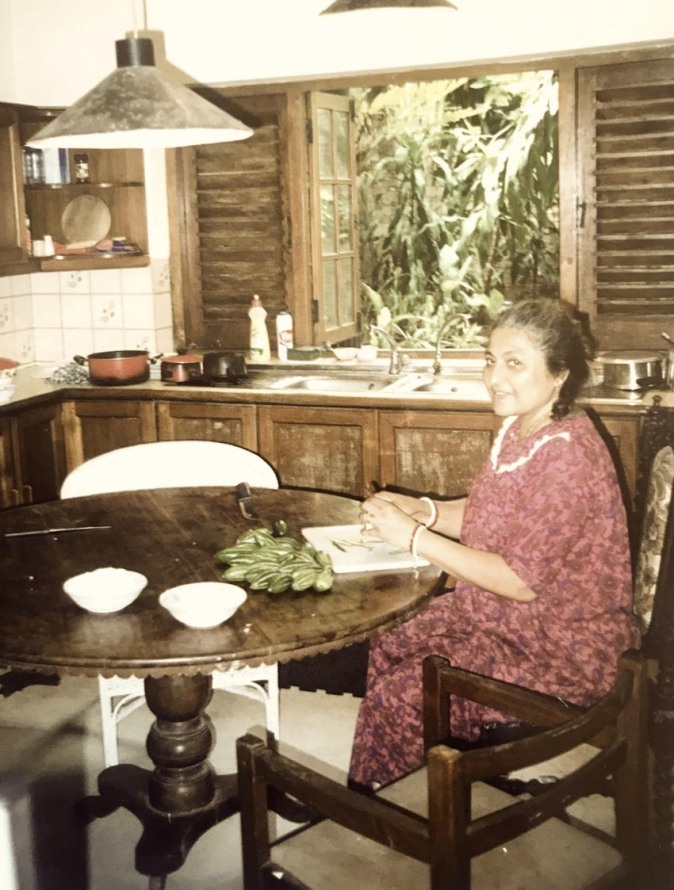 Mum-in-law cooking potol that she brought from Kolkata
Mum-in-law cooking potol that she brought from Kolkata
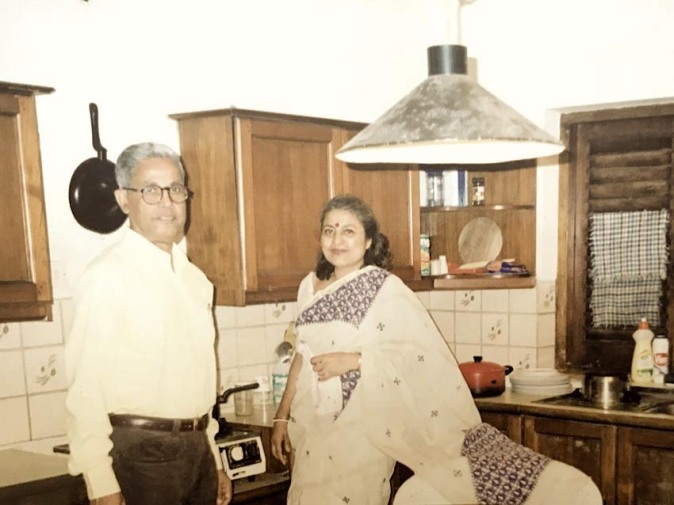 My parents-in-law dressed up for a formal dinner. The kitchen has always been our happy space!
My parents-in-law dressed up for a formal dinner. The kitchen has always been our happy space!
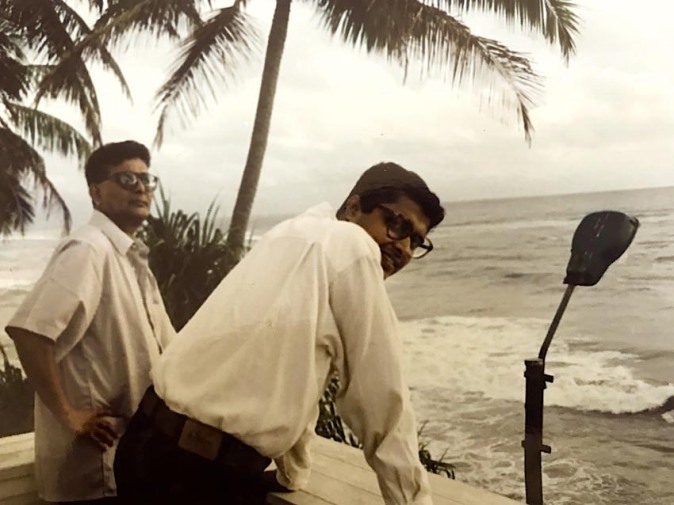 At the heritage property Mount Lavinia Hotel for a sundowner with my father
At the heritage property Mount Lavinia Hotel for a sundowner with my father
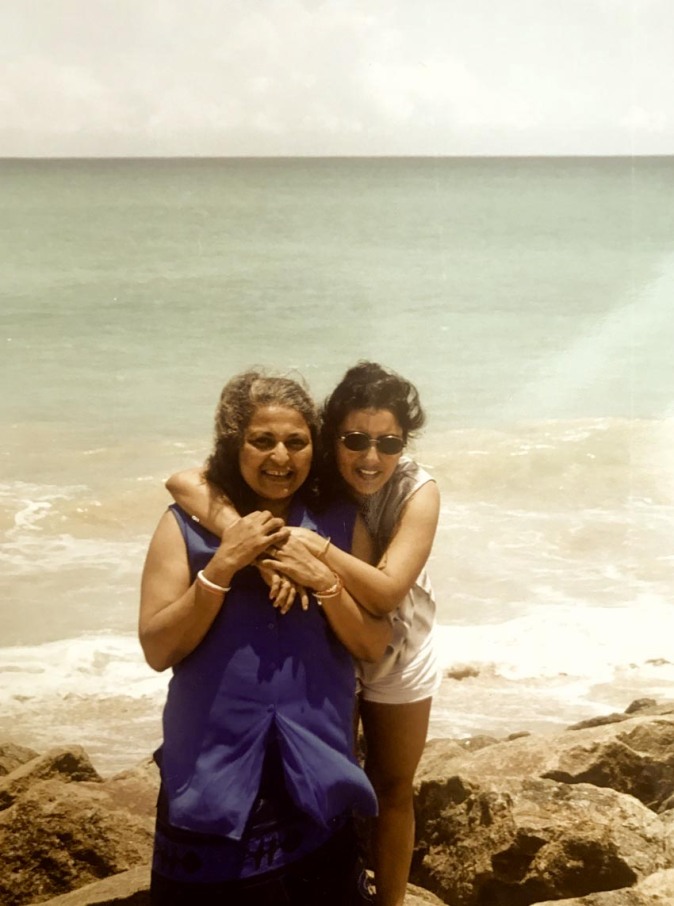 With my mum-in-law on our trip to Galle
With my mum-in-law on our trip to Galle
When my parents-in-law visited us, our kitchen soon became the focal point for all our hangouts and late night chit chats. We ‘binge-devoured’ on traditional Bengali meals cooked by mum-in-law. The first episode of the subsequent future seasons of her carrying potols and other typical Bengali food items in her suitcase when Ma visited us in different cities where we set up home, started from our Colombo days (here’s a story of food, love and good memories travelling in our suitcases)! I accompanied them back to Kolkata to celebrate my parents’ 25th anniversary on the condition that my father would drop me back to Colombo. We wanted everyone in our families back home to visit us in Colombo – such was the charm of the island and the house that we called our home!
My 3rd lesson in Srilanka… to grace kindness, humility and faith on a daily basis.
Our Srilankan friends showered us with immense love. Every person we met, was friendly, kind and smiling. While at home, we were surrounded by giggles and laughter, we were surrounded by joy in spite when we stepped out. This was despite all that was happening in their lives. We heard from how the civil war and the conflict in Jaffna affected the people. Every family had some incident to share that was a result of the conflict. Amidst all these conflicts however, what struck to me was how they had an unflinching faith and hoped for peace in their beloved island.
Discovering Srilanka

Colombo… the starting line
In the course of the year, I explored Colombo and Srilanka as and when S’s work permitted. While the city was new to me, S already had his favourite spots, which he proudly introduced me to. Ice cream sundaes at the dessert parlour Carnival in Galle Road, my first ‘food court’ meals at Liberty Plaza Food Court, tuk tuk rides to the seaside promenade Galle Face over the weekend (here’s my love story on tuk tuks!). The tuk tuk drivers would mistake S for a local and charge us the regular fare. On realising that we weren’t, they would start renegotiating! On our occasional visits to the lakeside Buddhist temple Gangaramaya, I learnt to emphasise on faith rather than any particular religion. Leaving spirituality aside, the material girl in me loved visiting Odel, the famous Srilankan department store. A short walk from our house, I loved the scented candles, colourful sarongs or their eclectic range of accessories. Every product on Odel’s self seemed to reflect the characteristics of the island and that really inspired me.
Bentota and Galle – the seduction of coastal Srilanka
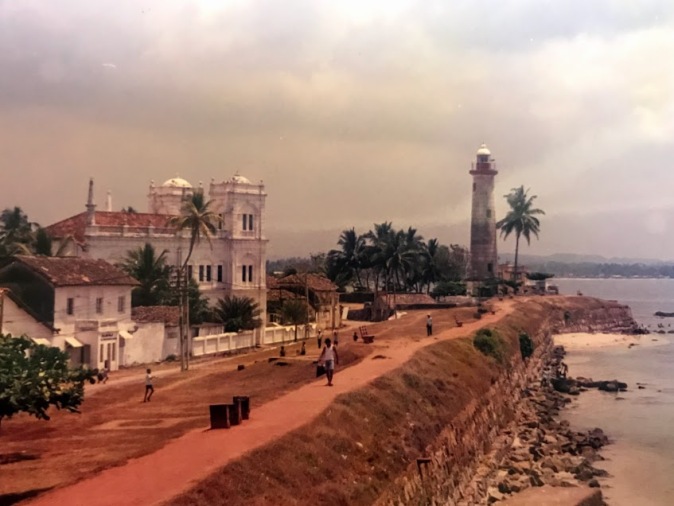 Galle’s colonial past is reflected in the architecture of its houses and fortifications
Galle’s colonial past is reflected in the architecture of its houses and fortifications
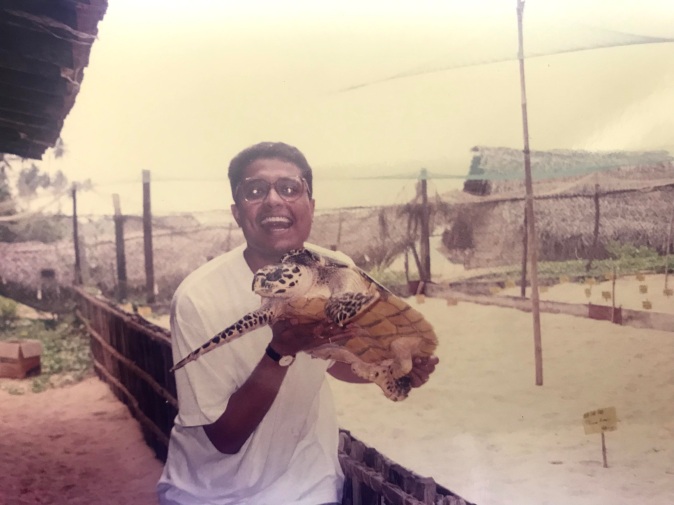 Many endangered species of turtles have been nurtured at the Turtle Hatchery Project at Bentota Beach
Many endangered species of turtles have been nurtured at the Turtle Hatchery Project at Bentota Beach
Our first trip out of Colombo was to Bentota, a laid back seaside town on the southwest coast. We stayed at the Serendib Beach Hotel, a causal beachfront property designed by the world famous architect Geoffrey Bawa. The architecture was characteristic of Bawa’s signature style – simplicity and a blend of the surrounding landscape. Our room on the ground-floor overlooked the serene sea through a grove of swaying coconut trees. Beach barbecues, grills of fresh catch by the table – specially King Fish, watching the locals scaling up coconut trees to tap toddy, sunsets over the sea, late night strolls by the beach and… watching one day old turtles in the nearby Turtle Hatchery – these are just a few of my favourite ‘Bentota’ memories from a long list. A day trip to the Galle situated on the southwest tip of the island, completed our first trip outside Colombo. Built in 16th century by the Portugese colonists, the old town of Galle with its historic fortifications, is inscribed in the UNESCO World Heritage list. Galle’s colonial past was reflected in its architecture and magnificent fortifications. The Portugese had arrived in the 16th century, the Dutch in the 17th century and subsequently followed by the British in late 18th century. The Portugese styled white-washed houses city exuded an old world charm. The Galle Lighthouse, standing tall on the fortification rampart, was one of the oldest in the country and still in use.
Kandy – a UNESCO World Heritage Site and an alluring ancient capital
 Kandy Lake is encircled with a decorative white parapet that resembles clouds. Built in early 19th century, there are many folklores associated with the lake
Kandy Lake is encircled with a decorative white parapet that resembles clouds. Built in early 19th century, there are many folklores associated with the lake
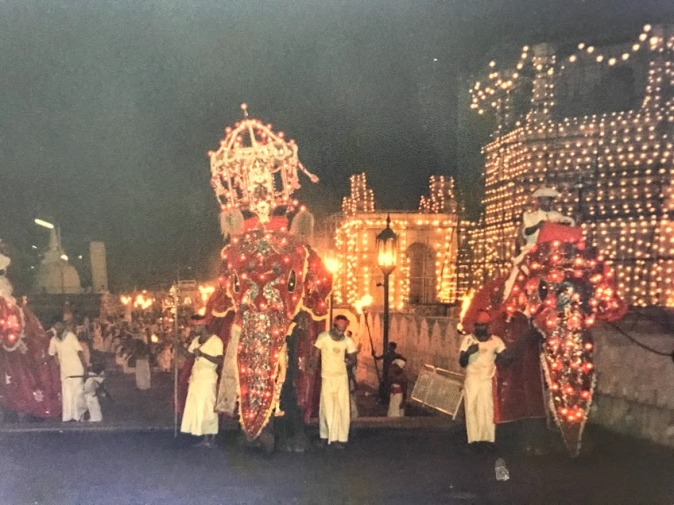 Kandy Esala Perahera or The Festival of the Tooth is a spectacular procession paying homage to Buddha’s sacred tooth relic
Kandy Esala Perahera or The Festival of the Tooth is a spectacular procession paying homage to Buddha’s sacred tooth relic
In August, we took a trip to Kandy, situated three hours away from Colombo amidst the scenic hills of Srilanka. We had booked into a B&B run by one of S’s colleague’s grandparents. The sacred city of Kandy comprising of The Temple of the Tooth Relic was another UNESCO World Heritage site. When we visited the temple, it was still reverberating from the damage left behind by a militant attack earlier in January, the same year. The shrine housed the relic of the tooth of the Buddha and was considered one of the holiest temples in Srilanka. We had planned our trip to coincide with Kandy Esala Perahera or The Festival of the Tooth. Held annually in July or August, the Perehera is a spectacular procession held annually to pay homage to Buddha’s sacred tooth relic which is carried in a golden casket by an elephant. We queued for hours so that we could watch the mesmerising procession standing in the first row. Elephants dressed up in ornamental garments, local folk as well as traditional Kandyan dancers, drummer dancers, fire dancers and many such heart stomping show-stopping activities were part of the procession. We walked the entire circumference of the picturesque Kandy Lake, a manmade lake with an island in the middle. Built in the medieval era, the lake was encircled with a decorative white parapet that resembled clouds. A beef preparation with kankun (water spinach) that we tasted in a restaurant that overlooked the lake and the simple breakfast at the guesthouse with homemade jams and Kiri Peni, a dessert made with curd and palm sugar treacle, still linger on my tastebuds.
Sinharaja – of hikes and forest trails
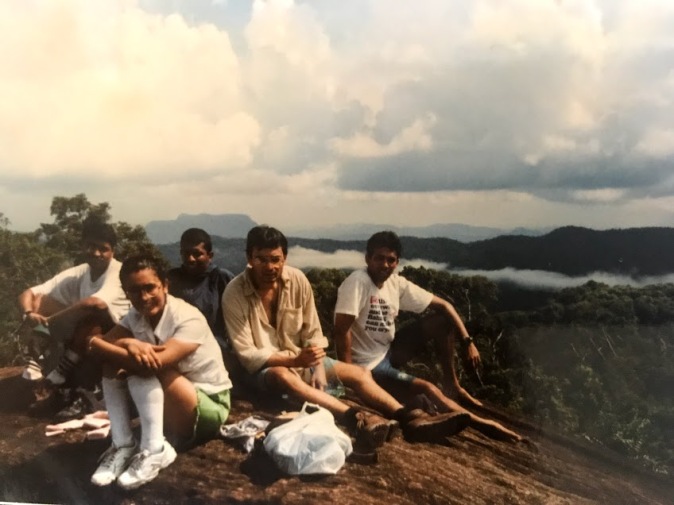 A small break while hiking in the rainforest. My need for wearing those long, thick football socks? Bloodsucking leeches, of course!
A small break while hiking in the rainforest. My need for wearing those long, thick football socks? Bloodsucking leeches, of course!
 The dense rainforest in Sinharaja National Reserve is home to many endemic species and sixty percent of the island’s endemic trees
The dense rainforest in Sinharaja National Reserve is home to many endemic species and sixty percent of the island’s endemic trees
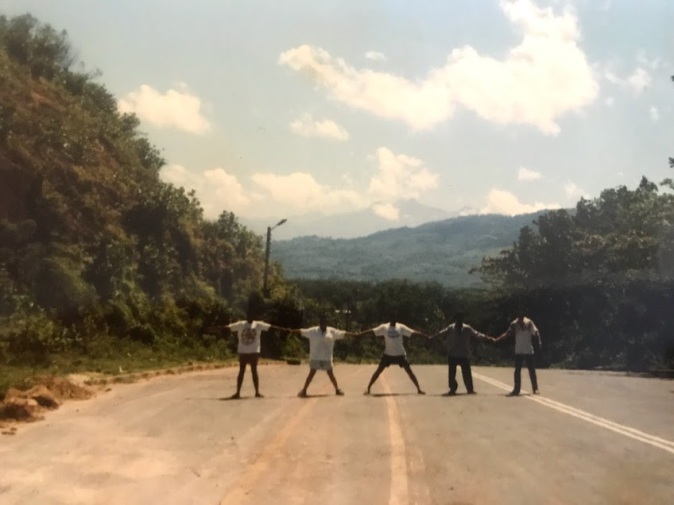 Posing on the highway – nothing is more exhilarating than outstretched hands without any inhibition
Posing on the highway – nothing is more exhilarating than outstretched hands without any inhibition
We went on a hiking trail once with the gang to the dense rainforest in Sinharaja National Park. Recognised as a World Biosphere Reserve as well as a World Heritage Site by UNESCO, the experience was thrilling. Gushing waterfalls and breath-taking views of the forest cover from vantage points made for several gorgeous photo-ops. A subsequent visit to a gem factory and museum at Ratnapura later, opened our eyes (literally so) to the various gemstones that the emerald shaped island was famous for. Those were the pre-digital smartcam days, hence limited captures only after several contemplations! One of my favourite pictures from our Srilanka albums is when our friend’s car broke down. We stood across the highway holding our outstretched hands. And a not-so-favourite moment? The leeches that kept on gnawing at us all along the forest trail!
Revisiting Srilanka – Bentota on repeat mode and hey you, digicam… you are so welcome!
 View of the Indian Ocean from Taj Bentota
View of the Indian Ocean from Taj Bentota
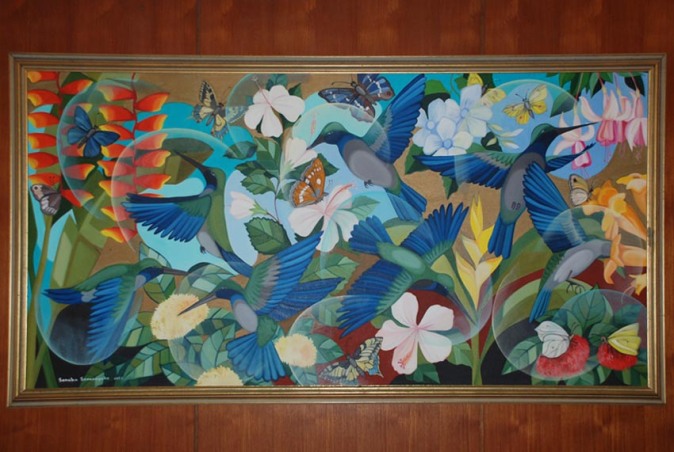 Senaka Senanayake’s signature style – bright hues depicting Srilanka’s flora and fauna
Senaka Senanayake’s signature style – bright hues depicting Srilanka’s flora and fauna
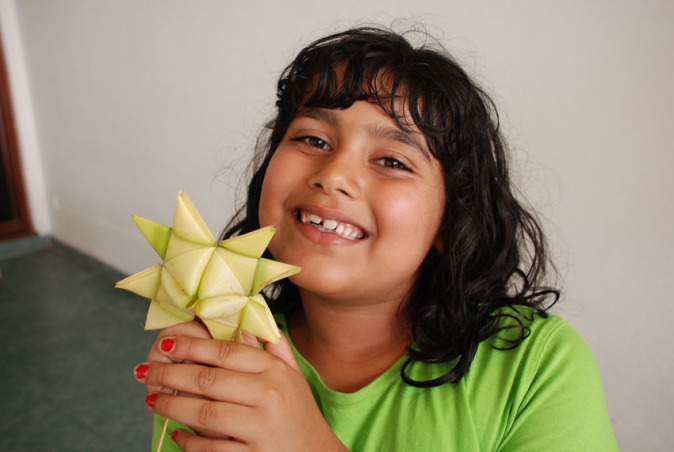 Big Z with her origami art
Big Z with her origami art
When we planned our first vacation beyond the annual Kolkata visits after Lil Z’s birth, our first choice of destination was obviously Srilanka. So off we headed back to the island in 2011. With the Z-Sisters accompanying us, we were exploring a different Srilanka this time – alibi a luxurious vacation mode. Naturally, Bentota had to be the first stop. We booked into Vivanta by Taj, a far cry from our humble holidays in our first years of marriage. Not that it seemed to matter in those earlier days of travelling. Perched on an elevated cliff with a stunning ocean view, Taj Bentota provided us with some precious moments – a mile long stretch of Bentota’s classic golden beach, origami activities, stunning ocean views and authentic Srilankan food. The other truly memorable experience for me was witnessing the work of Senaka Senanayake, one of Sri Lanka’s best-known artists. Several brightly hued canvases depicting Srilanka’s flora and fauna that are so characteristic of the artist, hung on the wall of Taj Bentota – a priceless collection indeed. We also visited the Kosgoda turtle farm nearby, as we wanted to share the experience of holding one-day old baby turtles with the Z-Sisters.
Kitulgala – a riverside rendezvous, an epiphany and the inception of my blog
 Kelani River in Kitulgala… most of the scenes in the ‘The Bridge on the River Kwai’ that were shot in Srilanka are in Kitulgala
Kelani River in Kitulgala… most of the scenes in the ‘The Bridge on the River Kwai’ that were shot in Srilanka are in Kitulgala
My 4th lesson in Srilanka… life always comes back in full circle. In doing so, it gives one ‘cues’ to the direction that leads straight from your heart. Grab them!
After the sunny seaside, we were headed to the scenic Hill Country of Srilanka. We stopped for lunch at the riverside ecolodge Rafters’ Retreat in Kitulgala (here’s my write up). The gushing Kelani river and mountainous forests brought back memories of my trip with the gang from a decade back. It was a similar landscape in Ratnapura where we had stopped impromptu… to bathe in Kalu Ganga! The riverside stop in Kitulgala this time, was momentous in my life. It was like an epiphany and my blog was born. Here’s an excerpt from my first blog post, written nine years back…
Re-visiting Srilanka was more than just a vacation. It was as if, we were searching for our own roots. A decade back we had stood by the banks of the Kelani river, letting our eyes wander into the woods. Now a decade later, the four of us were standing at the same spot. As if one circle of life just got completed.
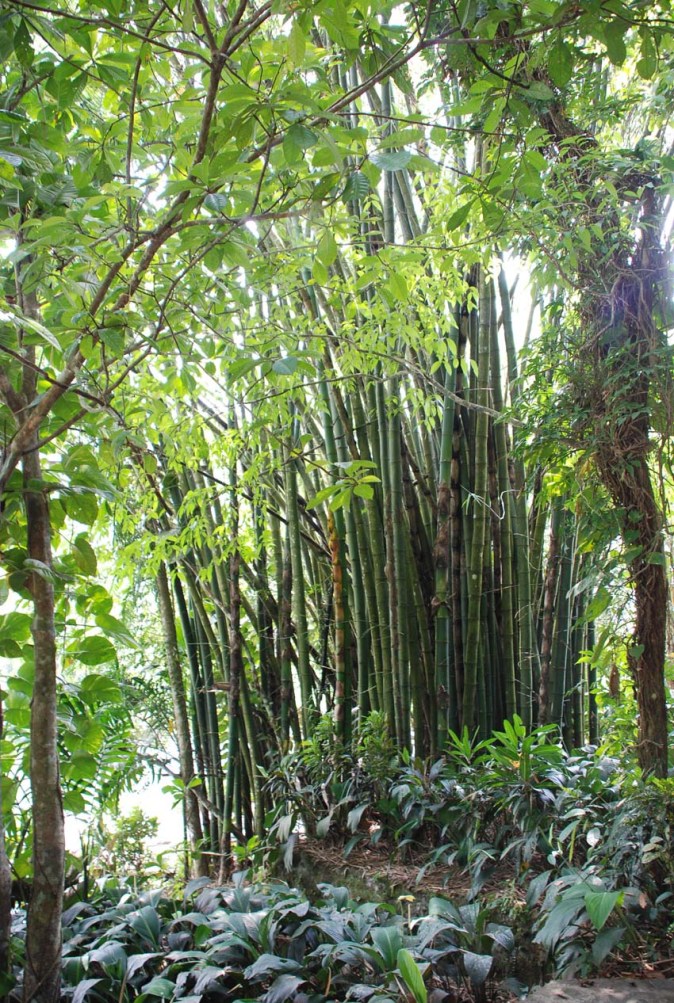 Kitulgala is one of the wettest places in Srilanka with two monsoons in a year
Kitulgala is one of the wettest places in Srilanka with two monsoons in a year
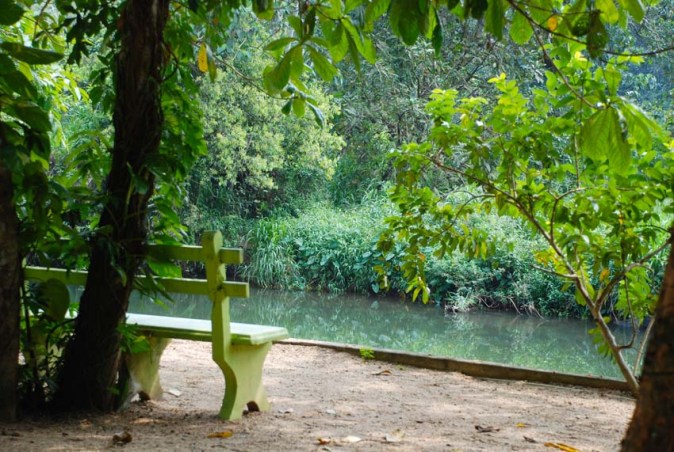
The empty bench by the Kelani River (in the picture above) seemed symbolic. With the beginning of the second circle with the four of us, I wanted to unblog them all. The surrounding greens, multiple shades of green reflected on the Kelani river and the empty bench beckoning me – this was predestined to be the first post of my blog IshitaUnblogged, all the way back in 2011!
Nuwara Eliya – the misty hills and romance of Ceylon tea
 The magnificent St. Clair’s Waterfall on our way to the Nuwara Eliya
The magnificent St. Clair’s Waterfall on our way to the Nuwara Eliya
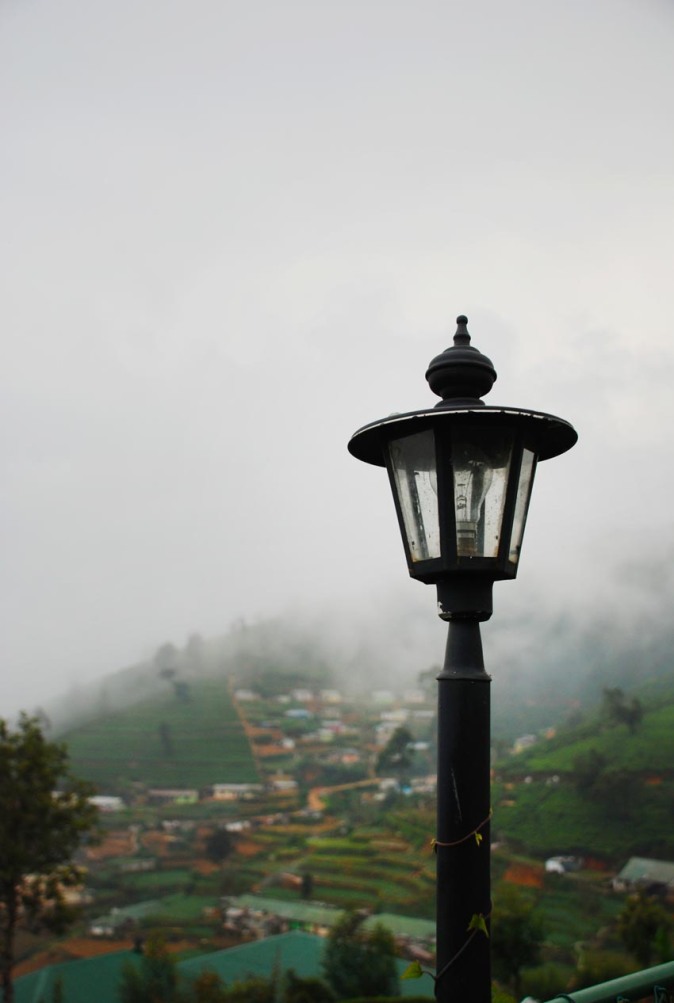 Misty hills of Nuwara Eliya
Misty hills of Nuwara Eliya
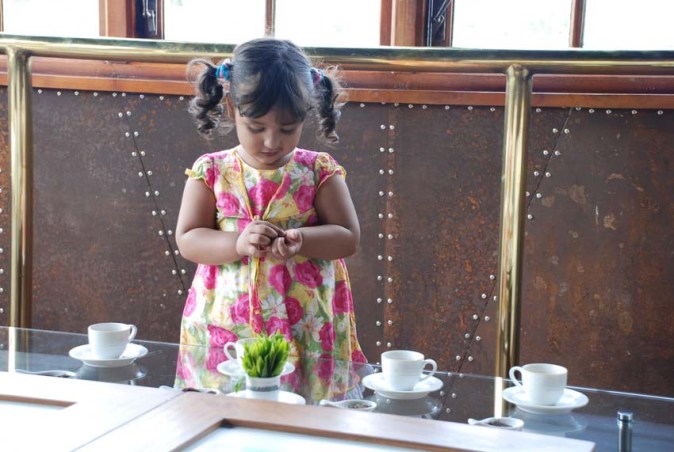 Two year old Lil Z picks on freshly plucked tea leaves to make her own version of Ceylon Tea
Two year old Lil Z picks on freshly plucked tea leaves to make her own version of Ceylon Tea 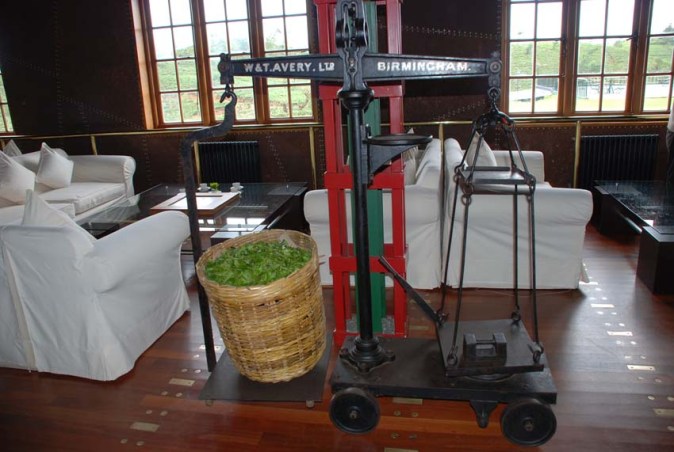 The original machineries from the tea factory have been preserved and are operational, forming aesthetic backdrops in the decor
The original machineries from the tea factory have been preserved and are operational, forming aesthetic backdrops in the decor
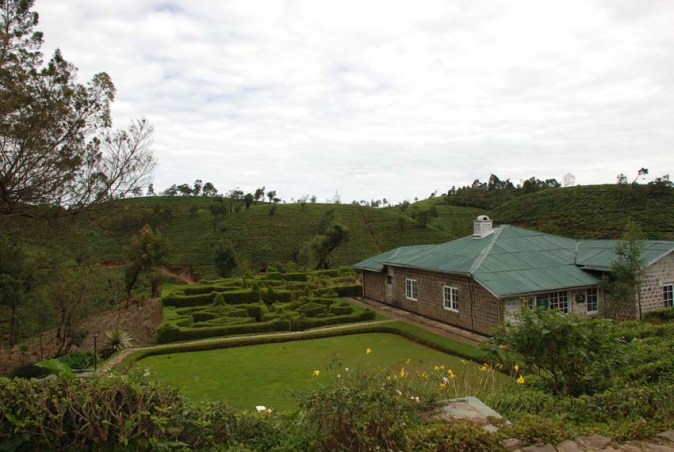 A small tour of the tea museum guided us through the tea making process – from withering to packing
A small tour of the tea museum guided us through the tea making process – from withering to packing
Rolling mountains, rippling waterfalls and mountainous streams marked the landscape as we drove into Srilanka’s scenic Hill Country. Set amidst lush green tea plantations and misty hills of Nuwara Eliya, our stay at Heritance Tea Factory is definitely one of my most unique stays (recalling our experience in my earlier write up). A colonial experience awaited us at this boutique hotel which was once a tea factory during the British Raj, the Hethersett Tea Plantation. The machineries from the original tea factory were still preserved and operational and were cleverly incorporated within the décor of the hotel. These machines were switched on from time to time offering a ceremonial spectacle for the resident guests. The sifting room was now converted to a formal restaurant – Kenmare. Wooden tea cartons held the buffet area serving authentic Sri Lankan cuisine as well as Western delicacies. Apart from Kenmare, there was another restaurant – TCK 6685 (Railway Carriage) Restaurant. It was a theme restaurant, a full-size replica of the actual train’s restaurant from the 1930s. Sitting on its small-gauge rails, the restaurant offered a unique fine dining experience complete with ‘whistle blowing’ and ‘toot-toots’. Food was served served by white-glove clad ‘attendants’ wearing their railway uniform. Our fondest and nerve wrecking culinary memories associated with our stay at Heritance was the formal five-course sit-down dinner on Valentine’s Day, complete with candle lights … along with the tiny Z-Sisters.
Revisiting Kandy – architectural splendour of a holy shrine
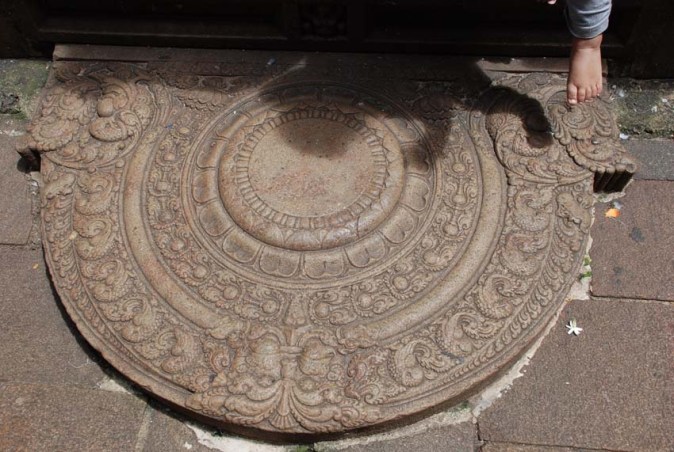 Lil Z stepping on the moonstone carved at the entrance. Much like a welcome mat, it is a unique feature of ancient Sinhalese architecture
Lil Z stepping on the moonstone carved at the entrance. Much like a welcome mat, it is a unique feature of ancient Sinhalese architecture
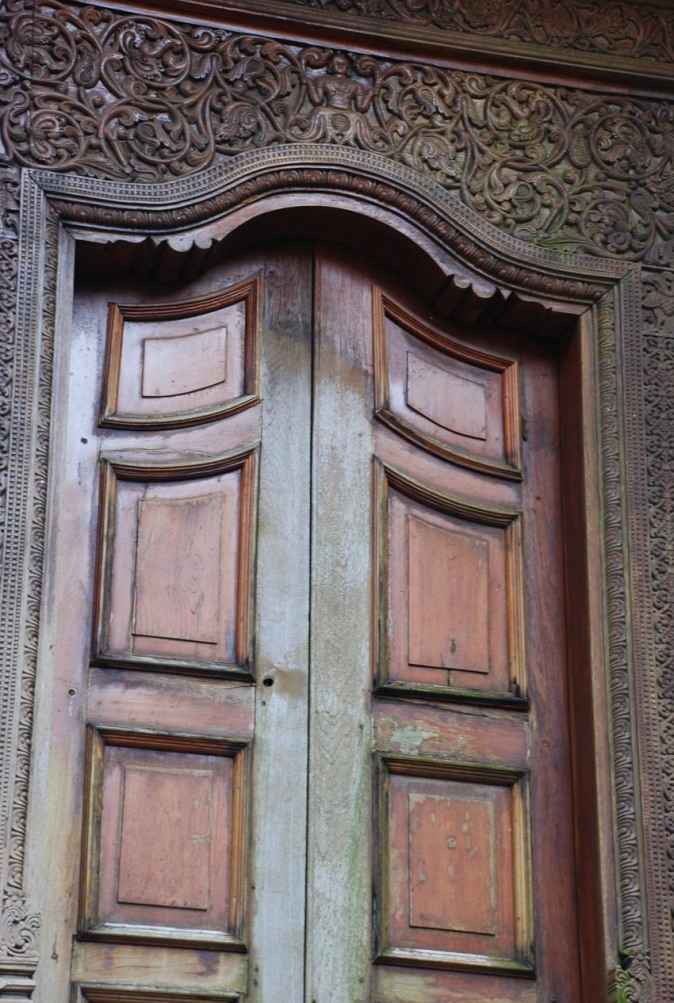 Intricate carvings on wooden doors
Intricate carvings on wooden doors
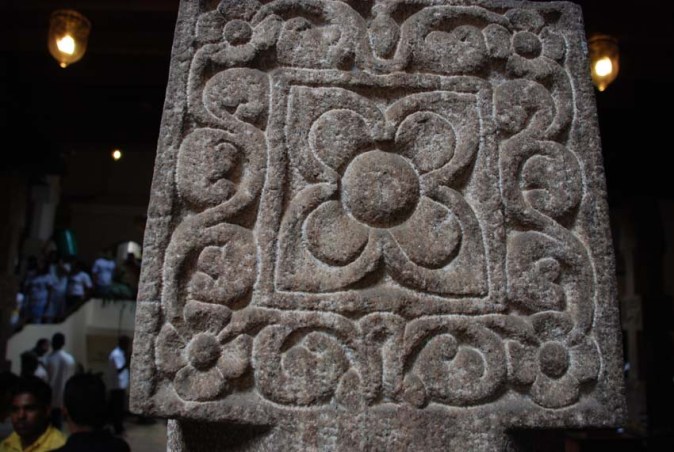 The stone carvings inside the temple date back to the 17th century
The stone carvings inside the temple date back to the 17th century
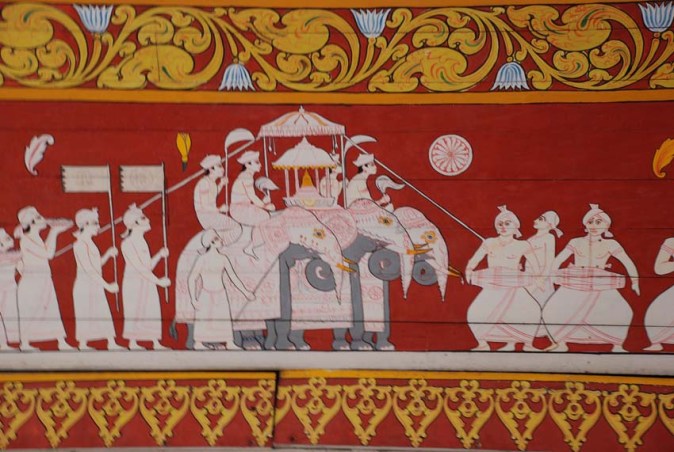 There are alfresco paintings on the ceiling of the temple. This one depicts a Perehera procession with the sacred casket bearer elephant, flag bearers and Kandyan dancers
There are alfresco paintings on the ceiling of the temple. This one depicts a Perehera procession with the sacred casket bearer elephant, flag bearers and Kandyan dancers
Our our journey downhill from Heritance Tea Factory, we revisited Kandy’s Temple of the Tooth Relic and offered prayers. Unlike on our first visit, when the temple and the palace complex was still undergoing restorations after the damages of the 1998 attack, I could completely immerse myself in the beauty of the temple this time. The architecture, stone carvings and the alfresco paintings were intricate and extraordinary. The temple has suffered considerable damage twice from bombings – once in 1989 and again in 1998, but both times it was restored fully as the relic is very important to Srilanka, both culturally and politically.
Pinnawala – sweet call of the wild
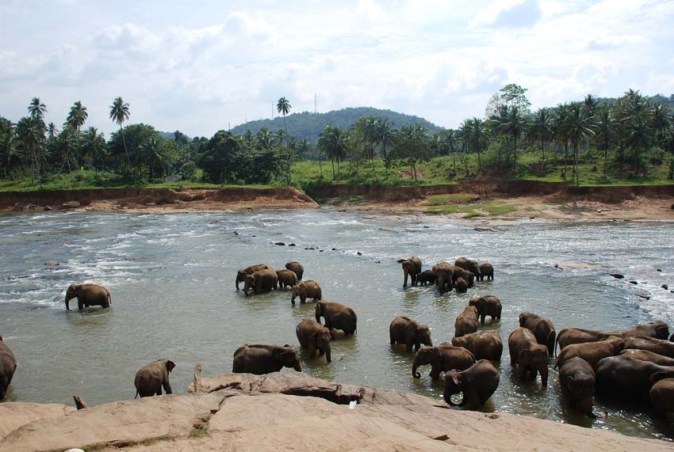 Herd of elephants gather at the bathing area in Pinnawala
Herd of elephants gather at the bathing area in Pinnawala
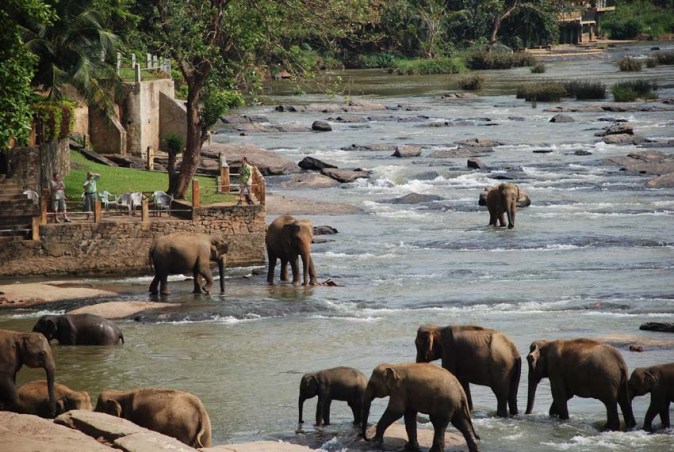 A spectacular sight in Pinnawala as herds of elephants of all ages come down to bathe
A spectacular sight in Pinnawala as herds of elephants of all ages come down to bathe
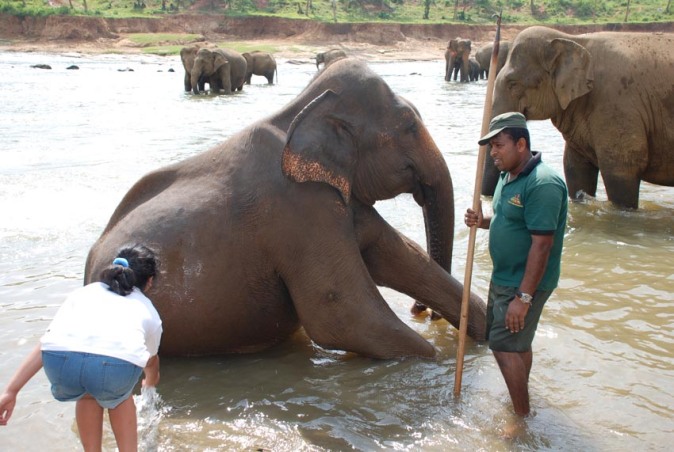
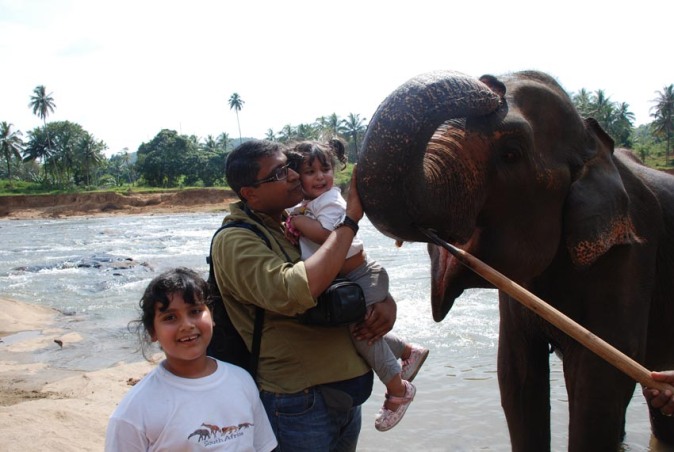
Pinnawala has the largest herd of captive elephants in the world and is known for its elephant orphanage – Pinnawala Elephant Orphanage. Initially built to nurture wild orphaned elephants, the orphanage has now also been breeding. Our lunch halt was synced with the elephants’ bathing time. The terrace at Grand Royal Pinnawala, just opposite the bathing site on Oya River offered a spectacular sight as herds of elephants of all ages came down to the river to bathe. Tourists could also partake in the bathing of elephants and feed them (with feeding bottles… awww!) at a charge. While Big Z loved joining in for the activities, Lil Z was in absolute tears!
Trincomalee – panoramic bays, stiff cliffs and white beaches
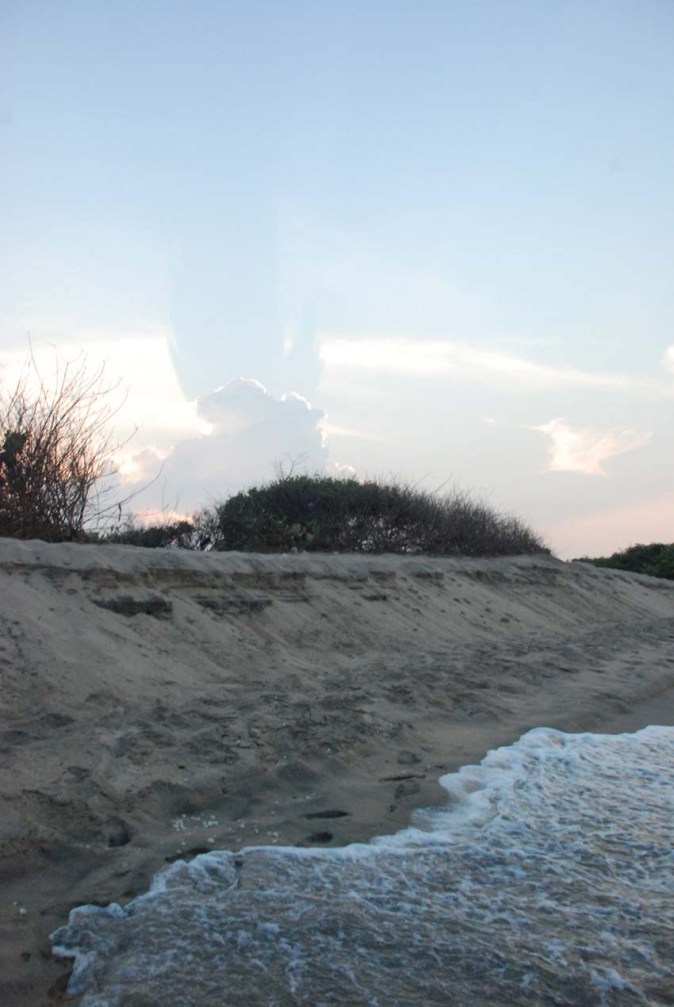 A walkway led us to from the deck of our beach chalet to the Jungle Beach Resort’s private beach
A walkway led us to from the deck of our beach chalet to the Jungle Beach Resort’s private beach
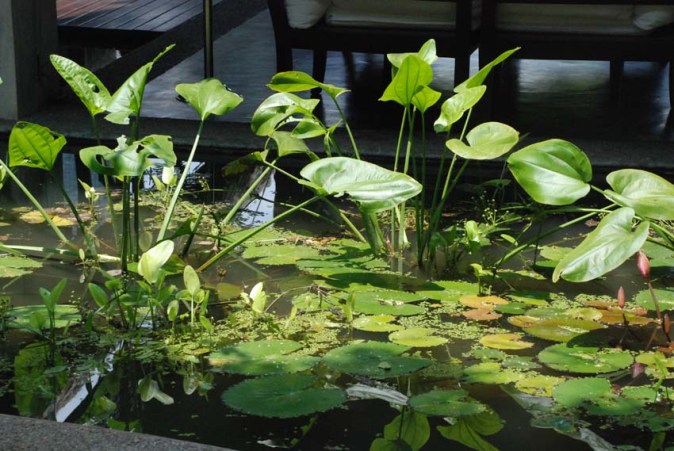 The resort’s breathtaking landscape scattered with lily pads, stone pathways amidst tropical foliage and vegetation. I also had a tiny snake encounter by the restaurant here!
The resort’s breathtaking landscape scattered with lily pads, stone pathways amidst tropical foliage and vegetation. I also had a tiny snake encounter by the restaurant here!
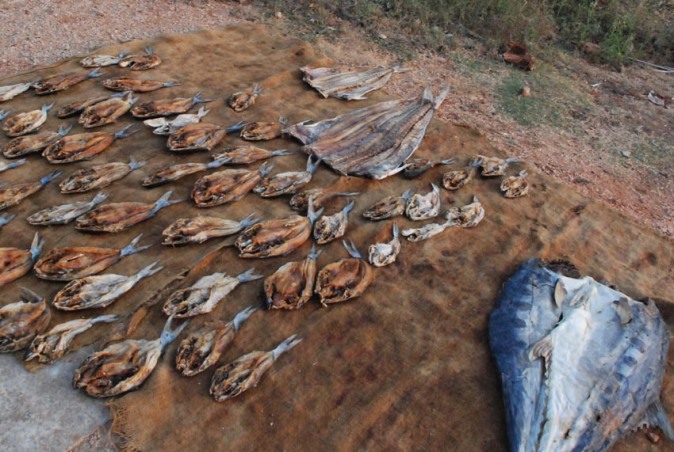 Fish being dried by the roadside in Trincomalee
Fish being dried by the roadside in Trincomalee
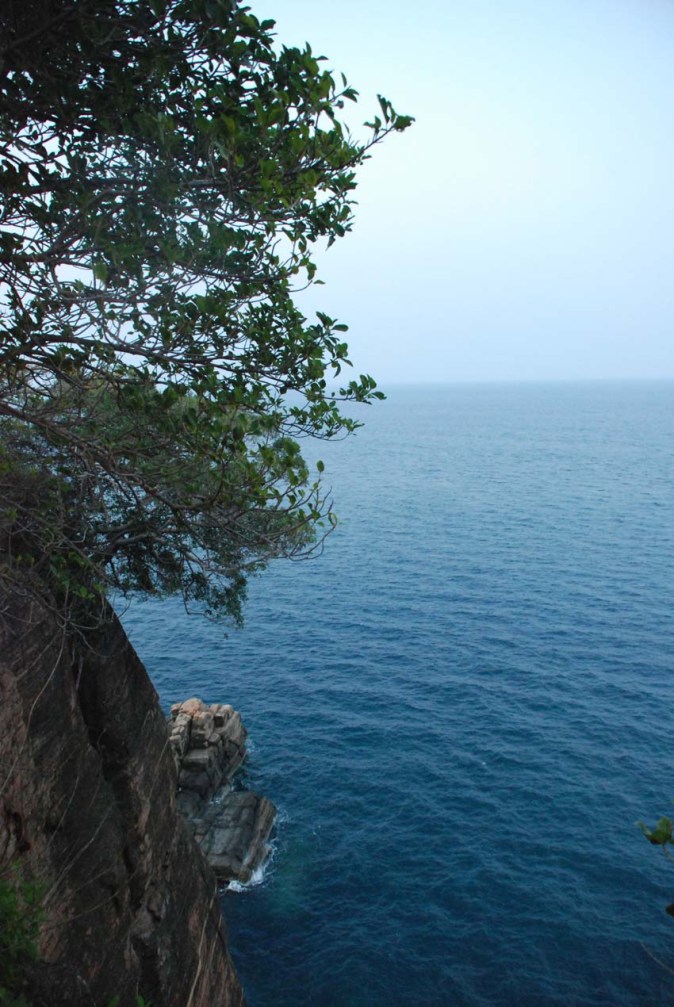 The view from Lovers’ Leap or Ravana’s cleft at Koneswaram temple, perched up high at 350ft above the sea level
The view from Lovers’ Leap or Ravana’s cleft at Koneswaram temple, perched up high at 350ft above the sea level
In 2014, we decided to visit Srilanka again. This time, our itinerary had only one place – Trincomalee, in the northeast coast of Srilanka. During the conflict days in Jaffna, Trincomalee was completely cut off for both residents and tourists. Apart from having the finest deep-sea natural harbours in the world, Trincomalee also boasted of one of the most beautiful stretches of white sandy beaches in Srilanka. Hence, our decision to visit Trincomalee, the moment we heard that it had opened up its tourism. We had a wonderful stay at the boutique resort Jungle Beach by Uga Escapes. With breathtaking views of the mangroves from our private deck, our beach chalet was luxurious and had thatched roofs and a vaulted ceilings. A walkway led us to the resort’s private beach from the deck. The resort’s restaurant was nestled around a lagoon set amidst a jungle vegetation. The focus was on fresh and locally sourced ingredients. Along with the typical breakfast spread, we also devoured the Srilankan offerings like hoppers, appams, dhal and curries. The Kiri Peni or curds was delicious and each day we were served a different variation. A very special memory is our private dining under a canopy of stars – a seafood barbecue against the backdrop of torched flames. We intentionally didn’t make too many plans while in Trincomalee, excepting a short drive to the city and a visit to the Koneswaram temple. A classical-medieval Hindu temple complex, the temple was perched up precariously on a cliff and the view of the ocean and the adjoining bays from there was stunning.
Colombo… once more
 The Z-Sisters by our favourite staircase at Rosmead Place
The Z-Sisters by our favourite staircase at Rosmead Place
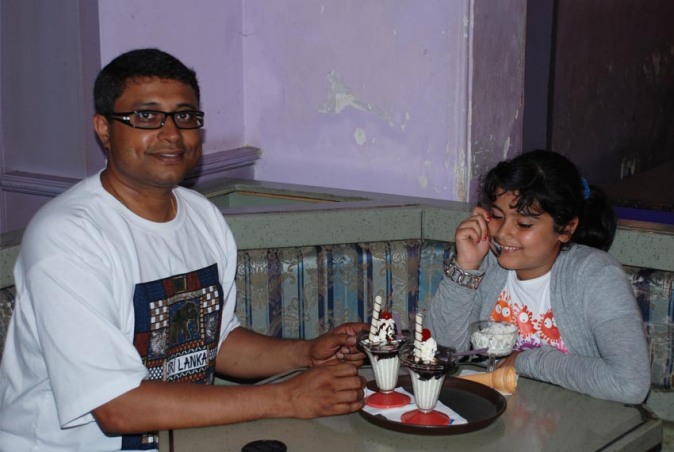 Revisiting Carnival’s for ice cream sundaes
Revisiting Carnival’s for ice cream sundaes
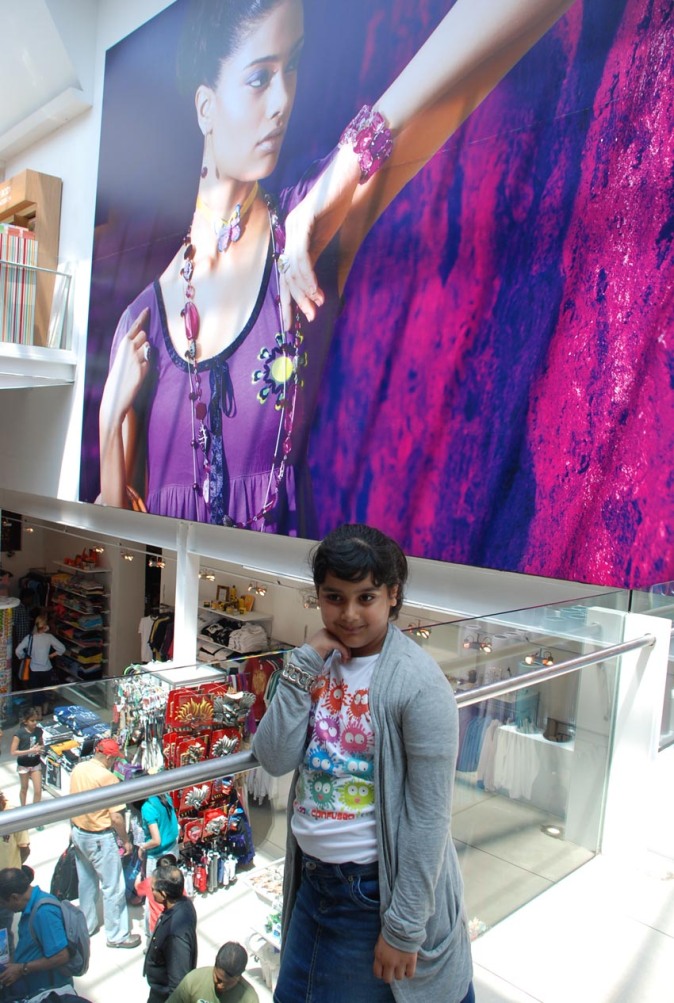 Odel, of course!
Odel, of course!
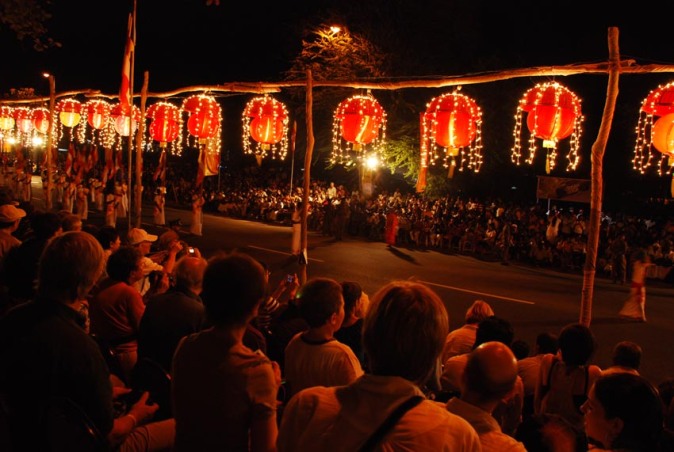 Watching the Navam Perehera in the comfort of VIP seatings
Watching the Navam Perehera in the comfort of VIP seatings
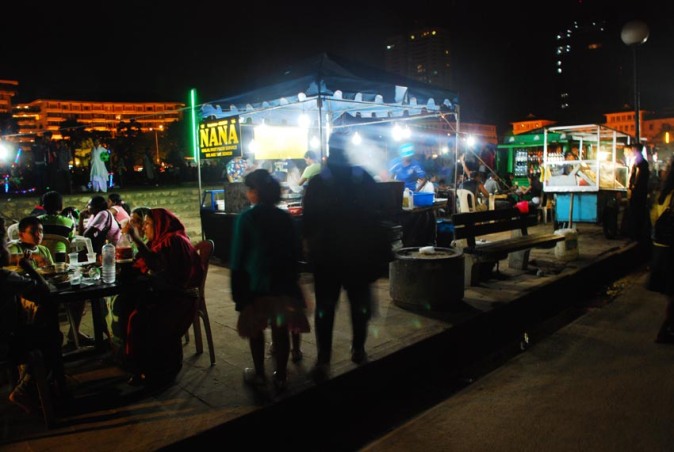 Food hawkers and other stalls at Galle Face promenade
Food hawkers and other stalls at Galle Face promenade
Our Srilanka trip was a recap for both of us as we revisited familiar places and showing them to the Z-Sisters. We were also exploring new places. In Colombo, we took the Z-Sisters to our house in Rosmead Place, visited Caravan for ice cream sundaes, ate at the food court in Majestic City and shopped at Odel, of course! We were staying in Taj Samudra where we brushed against some famous cricketers who were put up in the same hotel for an ongoing international cricket tournament. The hotel was located just opposite the Galle Face seaside promenade . Unlike in our Colombo days, the promenade was now lined with hawkers and food kiosks. From the devilled crabs and prawns to pineapple slices sprinkled with red chill flakes, everything looked extremely tempting. Finally, we settled for Kottu Rotis. While on our visit to the Gangaramaya temple, we learnt that a Perehera was being held the next day. Not wanting the Z-Sisters to miss out such an incredible opportunity, we bought VIP tickets that allowed seating… this is also something that we hadn’t known that one could do earlier! The Navam Perehera is held in Colombo on the Full Moon day in February. While we watched the Perehera in the comfort of seats, but alas it wasn’t from the front row as both S and I reminisced our experience of watching Kandy Esala Perehara a decade back!
Srilankan Food – spicy and spicier than thou!
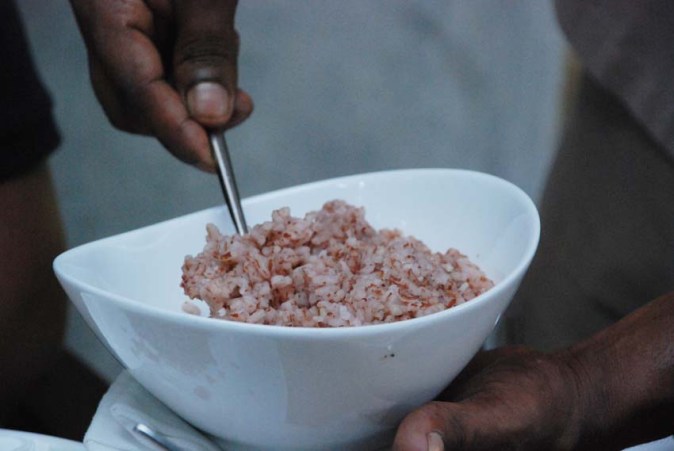 The short grained Srilankan rice – both red and white variety, is served for all Srilankan meals! At Jungle Beach Resort
The short grained Srilankan rice – both red and white variety, is served for all Srilankan meals! At Jungle Beach Resort
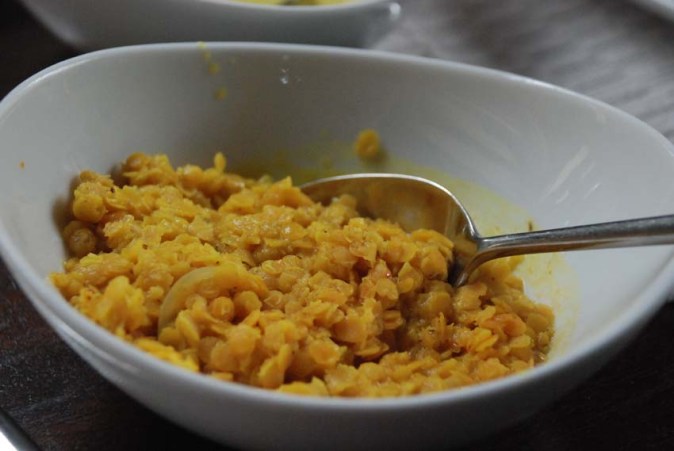 Parippu or Dhal Curry is made with red lentils (Masoor dal) cooked in coconut milk and seasoned with spices. At Jungle Beach Resort
Parippu or Dhal Curry is made with red lentils (Masoor dal) cooked in coconut milk and seasoned with spices. At Jungle Beach Resort
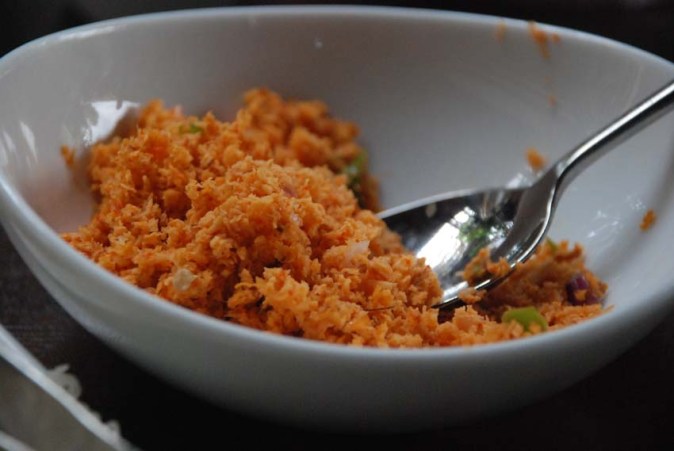 Pol Sambol is a spicy relish made with freshly grated coconut, onions, chillies and Maldive fish and eaten as an accompaniment. At Jungle Beach Resort
Pol Sambol is a spicy relish made with freshly grated coconut, onions, chillies and Maldive fish and eaten as an accompaniment. At Jungle Beach Resort
 Deviled crab at Jungle Beach Resort. Our favourite Srilankan seafood preparation is the deviled one – prawn, crab and squid
Deviled crab at Jungle Beach Resort. Our favourite Srilankan seafood preparation is the deviled one – prawn, crab and squid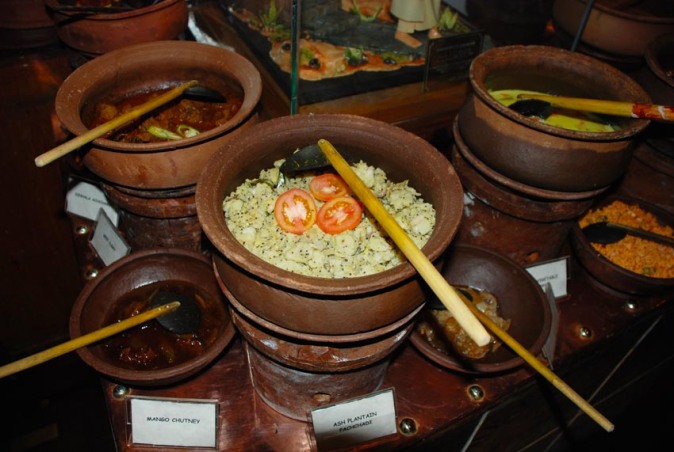 Srilankan food cooked and served in traditional clay pots in Heritance Tea Factory
Srilankan food cooked and served in traditional clay pots in Heritance Tea Factory
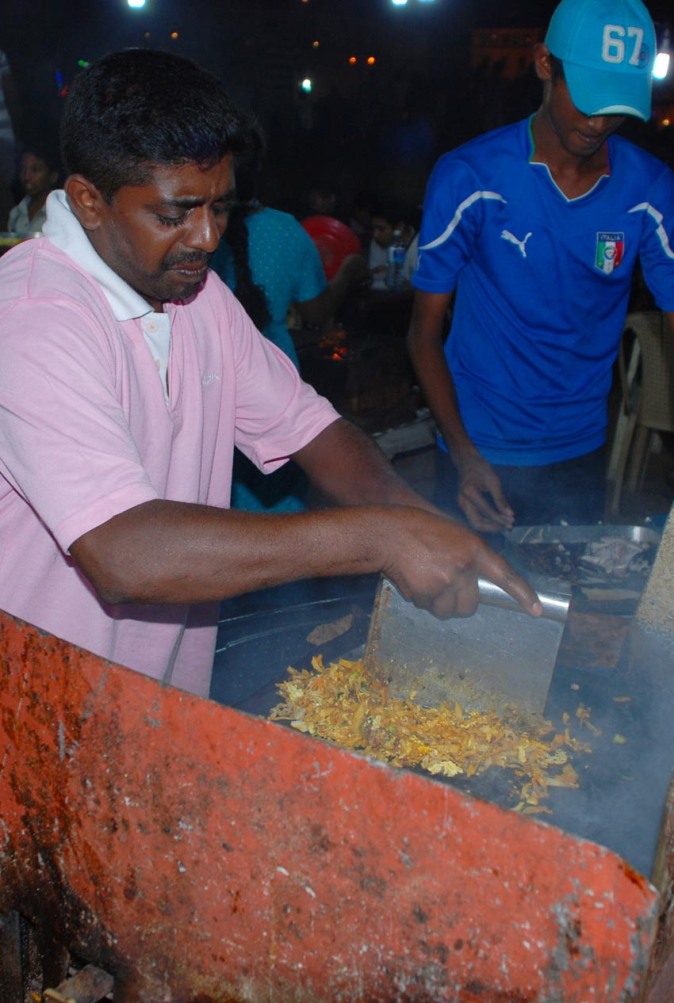 A food hawker making spicy Kottu Roti at Galle Face Promenade
A food hawker making spicy Kottu Roti at Galle Face Promenade
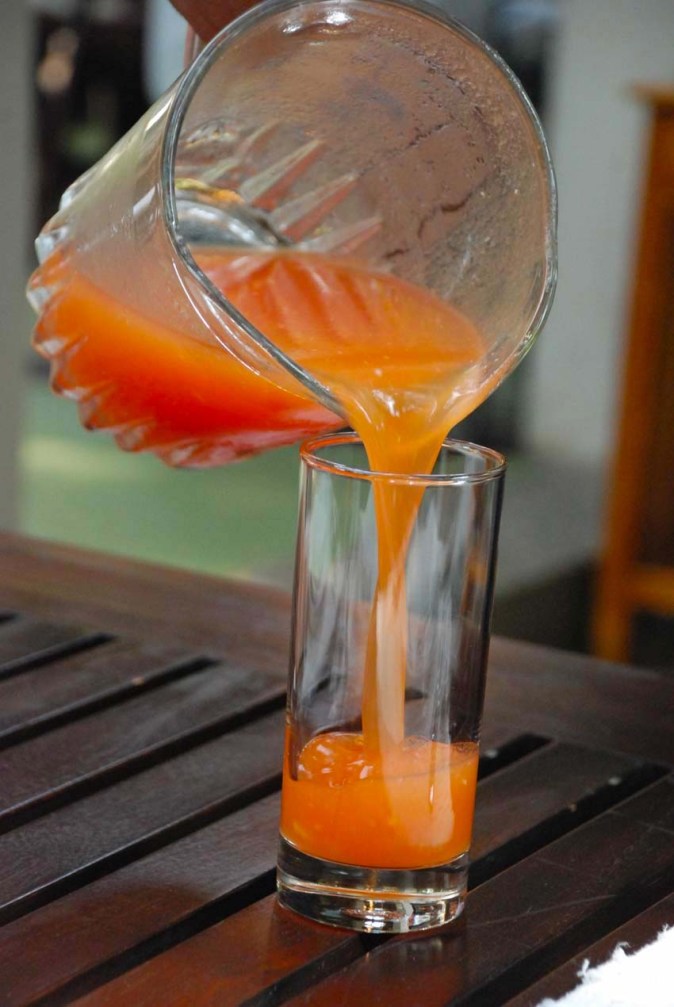 Sweet Papaya juice at Jungle Beach Resort
Sweet Papaya juice at Jungle Beach Resort
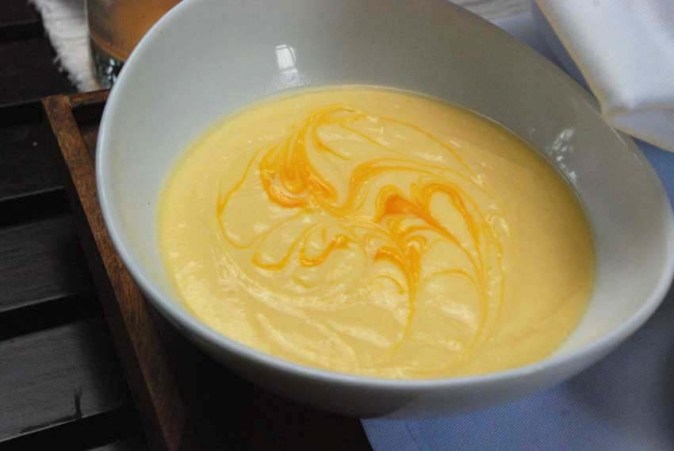 Mango Kiri Peni at Jungle Beach Resort
Mango Kiri Peni at Jungle Beach Resort
Once we were introduced to Srilankan food, there was no looking back! The spicy curries, the short-grained Samba rice and red rice, stir-fried shredded rotis or kottus, string hoppers, coconut sambols, fish cutlets, devilled prawns and cuttles – Srilankans loved their spices. I gradually acquired a liking for some of the popular fruits eaten in the island like jackfruits, mangosteens, custard apples and various kinds of bananas. I also had my first taste of Nasi Goreng and the banana wrapped Lamprais. Both these rice dishes captured the heart and soul of this rice-loving Bengali! I also fell in love with Wattalappan – a custard pudding made out of coconut milk and jaggery. When our Srilankan friends dined at our home, they couldn’t believe that there could be any curry that could be made without using red chillies. For that matter, we couldn’t believe the amount of chillies that actually went into making each one of their curries!
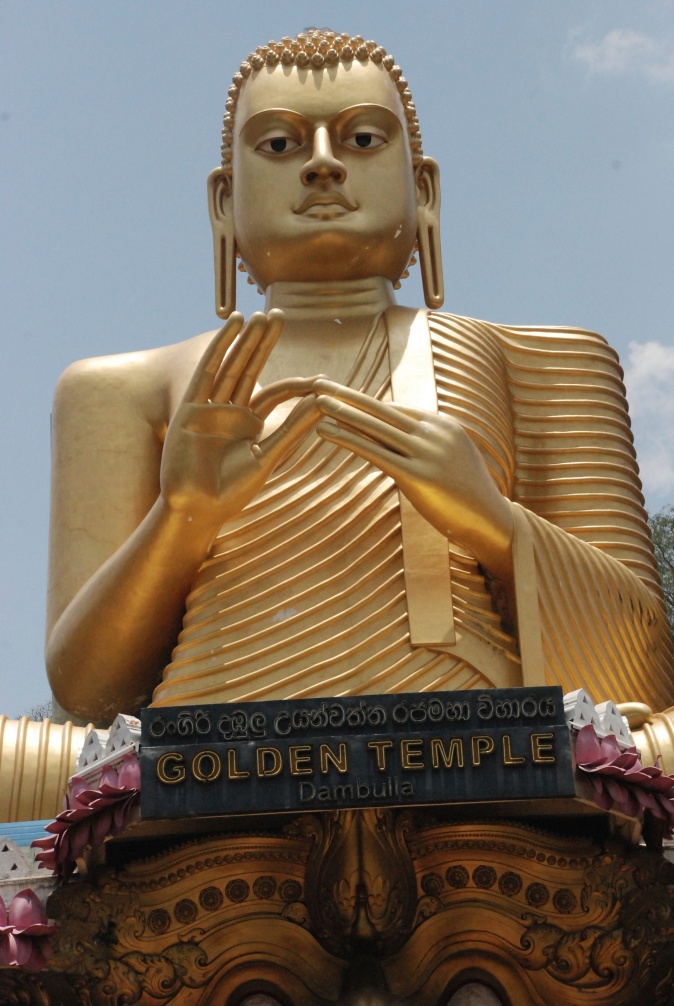 Dambulla Golden Temple, which we visited on our way back from Trincomalee to Colombo. A UNESCO World Heritage site, it’s the largest and best-preserved cave temple complex in Sri Lanka
Dambulla Golden Temple, which we visited on our way back from Trincomalee to Colombo. A UNESCO World Heritage site, it’s the largest and best-preserved cave temple complex in Sri Lanka
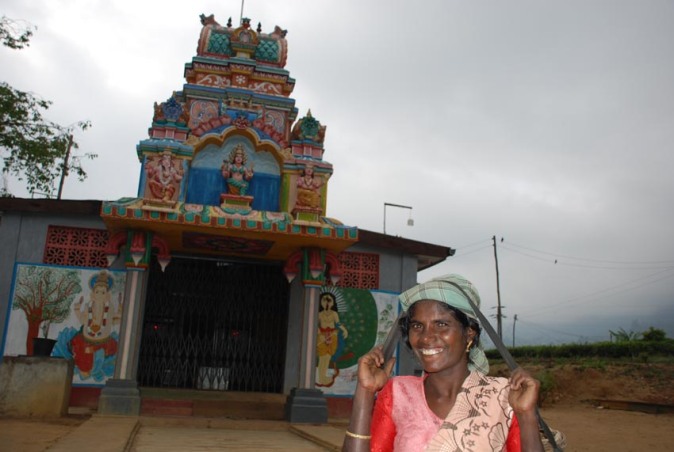 Wherever we went, we were met with evergreen smiles – look at the tea picker in Srilanka’s Hill Country!
Wherever we went, we were met with evergreen smiles – look at the tea picker in Srilanka’s Hill Country!
It’s time to return to Srilanka once again. And when we do, the topmost in our bucket list is to visit Ministry of Crab, the very famous seafood restaurant set up by celebrated chef and restaurateur Dharshan Munidas and cricketing legends Mahela Jayawardane and Kumar Sangakkara. Both the times we were in Colombo, the restaurant was closed as it was Poya or full moon day, considered auspicious by the Buddhists and a holiday in most places in the island. If it happens to be a Poya day once again on our next Colombo visit, I will consider that as predestined. I will happily settle for a food crawl in Galle Face promenade instead… digging into our eternal love – humble street food!
Last but not the least, the life lesson I learnt in Srilanka… life is a beautiful journey. It’s good to flip the album once in a blue moon to remember where it all started (not a full moon this time!). Most importantly to remind oneself, why we start a journey in the first case.
Unblogging it all… Ishita
Thank you for joining me on my daily food and travel journey on Pinterest, Instagram, Facebook and Twitter!
Here are a few of my articles on my Srilankan sojourn: Heritance Tea Factory Hotel, Nuwara Eliya Red tuk-tuks and triumphant rides – Colombo Living by the water with sunset as prop – Colombo and the Indian Ocean

Cooking Laprais was quite a feat and was elaborate, as it requires preparation of several dishes other. After going through several recipes on the internet, I chose this Lamprais recipe as it seemed most authentic to me along with the recipes of the accompanying dishes of Lampara meat curry, Seeni Sambol, Fish Cutlet, Fried Ash Plantain Curry and Wambatu Moju. To make the banana leaves soft and pliable for making the rice packets, pass them over a flame or grill on low heat, moving them constantly. Enjoy this legendary Srilankan dish!Lamprais
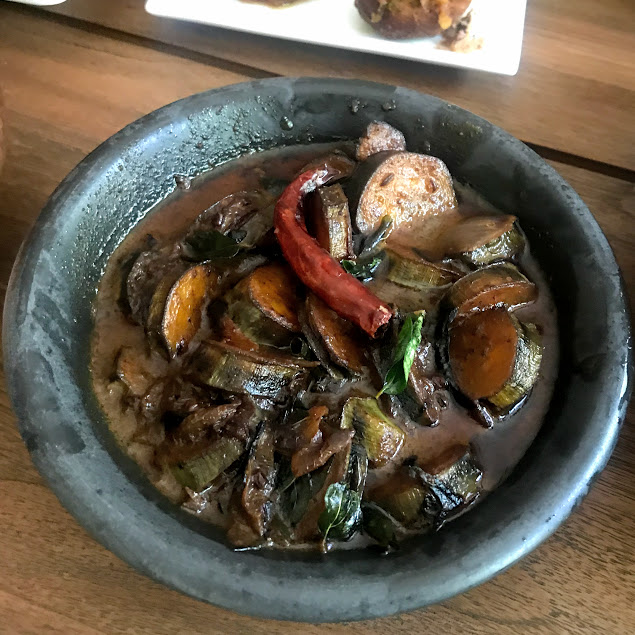 Wambatu Moju – an eggplant preparation
Wambatu Moju – an eggplant preparation
Disclaimer: This isn’t a sponsored post, nor are there any affiliated links for any of the brands that may have been mentioned in this blogpost. All meals, stays and other expenses have been paid by us. The subject, story, opinions and views stated here are my own and all images are from my personal album. While you enjoy reading my posts with lot of visuals, please do not use any material from these posts.
Srilanka is very special to me and my intention was to connect to all the places where we have lived, travelled and have good memories. I am sharing some links below that will help you to create similar itineraries when you wish to travel to Srilanka. Please note once again, that I haven't been paid to share these links. www.srilanka.travel (Srilanka Tourism) www.srilankan.com (Srilankan Airlines) www.emirates.com (Emirates Airlines) www.iamsrilanka.com (Travel agency based in Srilanka) www.alrostamanitravel.ae (Travel agency based in UAE)





Love ❤️ from srilanka
LikeLike
Sending love back to you dear Hashini !
LikeLike
Pingback: Finally calling Chennai home – IshitaUnblogged